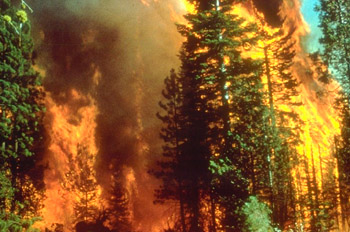Wildfire Preparedness:
Surviving and Preventing Wildfire, Wildfire Disaster Kit
Wildfire preparedness is advisable in hot dry weather in particular, although wildfires can occur at any time. The U.S. has a history of wildfires with as many as 100,000 annually, although smaller ones may not make headlines. Every year wildfires burn 4–5 million acres of land in the U.S. alone.
Wildfire Causes

When three elements such as flammable material like dry grass or trees, heat and oxygen come together, wildfires can occur. The sun, campfires, cigarettes, hot winds or even lightning can be the heat source — in fact, a small spark is all that is needed to start a wildfire. If other fuel sources are around, like gas or dried vegetation, the conflagration can spread quickly.
Wildfire preparedness is an important component of successfully dealing with these destructive and life threatening fires. Firefighters fight the fires with water and fire retardants as well as using controlled burns to reduce the spread of wildfires.
Preventing Wildfires as Wildfire Preparedness
As many wildfires occur due to human error, it makes sense to adopt preventive measures, such as:
- You should douse — no, drown — any lit campfire completely.
- While camping, make sure that fire lanterns, candles, logs, stoves, and heaters are cool before putting them away or leaving the campsite.
- Do not throw away cigarette butts carelessly anywhere, and especially not in wooded areas or places with dry grass.
- Call 911 or local fire officials if you spot any fire anywhere.
- Be careful in your home when lighting the barbecue.
- Store flammable liquids safely and away from heat sources.
Disaster Kit for Wildfires
Make and keep a disaster kit handy in case a wildfire threatens and you need to evacuate. To be prepared for an immediate evacuation, you should have a grab-and-go bag or disaster kit packed with:
- Flashlights with spare batteries
- Dry foods and water
- Battery powered or hand-cranked radio
- Medications
- First-aid supplies
- Cell phones with extra batteries
- A tool kit
- Extra clothes
- Blankets
- Essential toiletries and hygiene products
- Some cash
- Copies of important documents
- List of important phone numbers
Make Your House Safe
As part of wild fire preparedness, make sure your house is safe, especially if your house is near a wooded area or on a slope.
- Clear your yard and lawn of fallen leaves, debris, twigs and other grasses, which may be flammable.
- Ask the power company to clear branches which may fall across power lines.
- Keep your chimney outlet and stovepipe clean and make sure no branches are close to the outlets.
- Clear newspapers, cartons, packing material and rubbish regularly.
- Keep firewood and other combustibles away from your home, garage and garden.
- Make sure that you do not store flammable materials, including chemicals, in your garage.
- Keep fire extinguishers handy.
- Avoid using flammable materials for curtains and drapes.
- Keep your fire insurance up to date.
If you have received wildfire warnings, you should go to a safe area quickly. Shut off all utilities except water before leaving the house, and close doors and windows, but dont lock them, removing drapes if possible and keeping all flammable furniture and other items in the center of the room. Wear protective clothing and leave with your disaster kit.
If you are passing through smoke filled environments, make sure that your eyes and nose are protected, as many injuries occur due to smoke inhalation. If intense heat or flames are present, cover as much of your face as possible with a wet cloth. If you do get burns, cool them as quickly as you can and seek medical attention.
Raging fires sweeping the countryside can be terrifying experiences. Wild fire preparedness gives you a plan of action to lessen the devastation and give you some control over your safety in a dangerous situation.
Return from Wildfire Preparedness to Survival Situations





New! Comments
Have your say about what you just read! Leave me a comment in the box below.